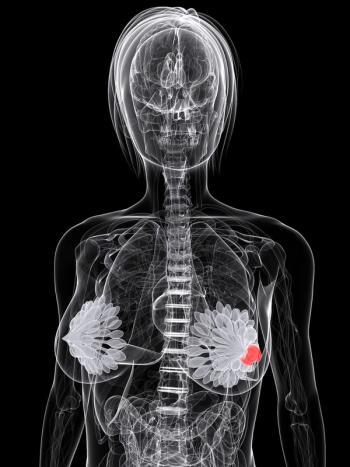
EC Approves Cabozantinib Monotherapy in Previously Treated pNET/epNET
Results from the phase 3 CABINET trial demonstrated a clear progression-free survival benefit with cabozantinib vs placebo in patients with well-differentiated pNET/epNET.
The European Commission (EC) has approved cabozantinib (Cabometyx) as a therapy for patients with unresectable or metastatic, well-differentiated pancreatic and extrapancreatic neuroendocrine tumors (pNETs; epNETs) who progressed on at least 1 prior systemic therapy other than somatostatin analogues, according to a press release from the developer, Ipsen.1
In June 2025, the European Medicines Agency’s Committee for Medicinal Products for Human Use (CHMP)
Supporting results from the phase 3 CABINET trial (NCT03375320), which evaluated the safety and efficacy of cabozantinib vs placebo in patients with pNETs or epNETs who progressed on systemic therapy, were published in the New England Journal of Medicine.4
In the epNET cohort, with a median follow-up of 10.2 months (95% CI, 8.2-13.8), the median progression-free survival (PFS) was 8.4 months (95% CI, 7.6-12.7) with cabozantinib and 3.9 months (95% CI, 3.0-5.7) with placebo, representing a 62% lower risk of disease progression or death with cabozantinib (HR, 0.38; 95% CI, 0.25-0.59; P <.001).
Partial responses (PRs) occurred in 5% (95% CI, 2%-10%) of patients in the cabozantinib group and 0% (95% CI, 0%-5%) in the placebo group (P = .05). The best response was stable disease in 65% and 54%, respectively, of patients and progressive disease in 11% and 35%; any reduction in the target lesions occurred in 67% and 29%.
At the median follow-up time for survival of 24.2 months, the median overall survival (OS) was 21.9 months with cabozantinib and 19.7 months with placebo (HR, 0.86; 95% CI, 0.56-1.31). It was also noted that the overall health-related quality of life was stable and similar in patients who received cabozantinib and placebo.
In the pNET cohort, with a median follow-up of 13.8 months (95% CI, 10.1-19.7), the median PFS was 13.8 months (95% CI, 9.2-18.5) with cabozantinib and 4.4 months (95% CI, 3.0-5.9) with placebo, representing a 77% reduction in the risk of disease progression or death with cabozantinib (HR, 0.23; 95% CI, 0.12-0.42; P <.001).
PRs occurred in 19% (95% CI, 10%-30%) of patients in the cabozantinib group and 0% (95% CI, 0%-11%) of the placebo group. The best response was stable disease in 61% and 55%, respectively, of patients and progressive disease in 8% and 39%; any reduction in the target lesions occurred in 80% and 24%.
The median OS, with a median follow-up of 23.1 months, was 40.0 months with cabozantinib and 31.1 months with placebo (HR, 0.95; 95% CI, 0.45-2.00). The overall health-related quality of life was similar in both the cabozantinib and placebo groups.
“Sequential use of systemic therapies remains challenging in the different types of NET that may arise from various organ sites. The number of available therapies is limited, and not all patients with NET may benefit from currently approved therapies,” stated Marianne Pavel, MD, endocrinologist, NET expert, and professor at the Department of Medicine 1, Friedrich-Alexander University of Erlangen, Germany, in the press release.1 “Advancements like those achieved through the CABINET phase [3] study, as recognized by the approval for [cabozantinib] in a wide range of NET, are offering new treatment opportunities to delay disease progression in patients with well-differentiated NET, irrespective of the type of neuroendocrine tumor.”
In the CABINET trial, 203 patients were enrolled in the epNET cohort and 95 patients in the pNET cohort. Within each cohort, patients were assigned 2:1 to receive either cabozantinib or placebo. Treatment consisted of oral cabozantinib at 60 mg once daily or a matching placebo.
Eligible patients were 18 years or older with histologically confirmed, locally advanced or metastatic well- or moderately differentiated epNET or pNET who had progressive disease per RECIST v1.1 in the 12 months leading up to enrollment, and an ECOG performance status from 0 to 2.
The trial’s primary end point was PFS. Secondary end points included confirmed objective response, OS, and safety.
Regarding safety in the epNET cohort, the most common any grade treatment-related adverse effects with cabozantinib were fatigue (62%), diarrhea (56%), aspartate aminotransferase level increase (65%), alanine aminotransferase level increase (58%), and hypertension (53%); the most common grade 3/4 TRAEs were hypertension (22%), fatigue (11%), leukopenia (11%), and palmar-plantar erythrodysesthesia (10%).
In the pNET cohort, the most common any grade TRAEs with cabozantinib were fatigue (75%), diarrhea (59%), aspartate aminotransferase level increase (63%), alanine aminotransferase level increase (62%), and hypertension (57%); the most common grade 3 to 5 TRAEs were hypertension (21%), fatigue (13%), and diarrhea (11%).
“The complex nature of neuroendocrine tumors and lack of innovation in recent years has resulted in significant physical and emotional strain for patients as their disease progresses,” Sandra Silvestri, MD, PhD, executive vice president and chief medical officer of Ipsen, said in the release.1 “We are pleased that for the first time, this approval offers a unique, simplified, and efficacious treatment option upon progression, where few to no other options currently exist. We look forward to working with local health authorities to make [cabozantinib] available to even more patients, reinforcing our longstanding commitment to delivering transformational therapies in oncology.”
References
- Cabometyx approved in the EU for previously treated advanced neuroendocrine tumors. News release. Ipsen Pharma. July 24, 2025. Accessed July 24, 2025. https://tinyurl.com/344hud4u
- Exelixis’ partner Ipsen receives positive CHMP opinion for CABOMETYX (cabozantinib) for patients with previously treated advanced neuroendocrine tumors. News release. Exelixis Inc. June 20, 2025. Accessed July 24, 2025. https://tinyurl.com/2evx7rdd
- FDA approves cabozantinib for adults and pediatric patients 12 years of age and older with pNET and epNET. News release. FDA. March 26, 2025. Accessed July 24, 2025. https://tinyurl.com/chw5v9a8
- Chan JA, Geyer S, Zemla T, et al. Phase 3 trial of cabozantinib to treat advanced neuroendocrine tumors. N Engl J Med. 2025;392(7):653-665. doi:10.1056/NEJMoa2403991
Newsletter
Stay up to date on recent advances in the multidisciplinary approach to cancer.
















































































